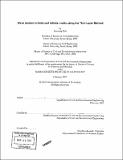| dc.contributor.advisor | Eduardo Kausel. | en_US |
| dc.contributor.author | Park, Joonsang, 1969- | en_US |
| dc.contributor.other | Massachusetts Institute of Technology. Dept. of Civil and Environmental Engineering. | en_US |
| dc.date.accessioned | 2008-11-07T20:18:24Z | |
| dc.date.available | 2008-11-07T20:18:24Z | |
| dc.date.copyright | 2002 | en_US |
| dc.date.issued | 2002 | en_US |
| dc.identifier.uri | http://hdl.handle.net/1721.1/43616 | |
| dc.description | Thesis (Ph. D.)--Massachusetts Institute of Technology, Dept. of Civil and Environmental Engineering, 2002. | en_US |
| dc.description | Includes bibliographical references (p. 449-454). | en_US |
| dc.description.abstract | The Thin-Layer Method (TLM) is a semi-analytical technique that is efficient for wave propagation problems involving partially heterogeneous media. While the method has been used widely for horizontally stratified media, e.g. dynamic response of foundations over layered soils, there remain many unexplored aspects. These include a thorough evaluation of the TLM's accuracy and range of applicability as well as its extension to semi-infinite and infinite media. Based on these considerations, we have three main goals to pursue in this study. The first one is to explore and improve the accuracy and convergence of the TLM associated with finite media. The second one is to extend the applicability of the TLM to model and analyze semi-infinite and infinite multilayered media. The third one is to develop two novel TLM's that are useful in analyzing wave motions in cylindrically or spherically laminated solids and shells. We proceed our study by separating it into the following three parts. In the first part, we begin by characterizing numerical dispersion phenomena in the TLM by means of general solutions and frequency spectra for discrete homogeneous full-spaces, which are obtained in closed-form with the aid of a finite difference scheme. Then, we determine the optimal combination of the consistent and lumped mass matrices by introducing tuning factors into the discrete system of equations. As a result, we improve the accuracy of not only the eigenvalues associated with free-vibration problems, but also the modal responses to external dynamic loads. | en_US |
| dc.description.abstract | (cont.) To assess the accuracy and convergence of the modal solutions, we compute both the displacements and internal stresses for some canonical examples and then compare with the associated exact analytical solutions. From this exploration, we discover various aspects of the TLM modal solutions in connection with the spatial-temporal characteristics of sources and receivers. We consider both the linear and quadratic expansion TLM' s. Finally, we determine the reasonable numbers of thin-layers per wavelength needed to calculate accurate responses with the TLM. In addition, we find out that the quadratic expansion TLM is more accurate and efficient than the linear expansion TLM. In the second part, we utilize the substructure method and the paraxial approximation for the purpose of analyzing the semi-infinite and infinite multilayered media by means of the TLM. The substructure method is applied to the TLM formulation in the time-domain, while the paraxial approximation is used for the TLM formulation in the frequency-domain. In addition, for the application of the substructure method, we derive new closed-form Green's functions in the wavenumber-time domain for a homogeneous half-space by means of contour integration. We extensively investigate the characteristics of the both formulations to improve their stability and accuracy. For stable and effective calculation, we propose the use of an artificial buffer layer and an adaptive buffer layer for the time-domain and frequency-domain formulations, respectively. Furthermore, we also derive the exact analytical Green's functions in the space-frequency domain ... | en_US |
| dc.description.statementofresponsibility | by Joonsang Park. | en_US |
| dc.format.extent | 454 p. | en_US |
| dc.language.iso | eng | en_US |
| dc.publisher | Massachusetts Institute of Technology | en_US |
| dc.rights | M.I.T. theses are protected by
copyright. They may be viewed from this source for any purpose, but
reproduction or distribution in any format is prohibited without written
permission. See provided URL for inquiries about permission. | en_US |
| dc.rights.uri | http://dspace.mit.edu/handle/1721.1/7582 | en_US |
| dc.subject | Civil and Environmental Engineering. | en_US |
| dc.title | Wave motion in finite and infinite media using the Thin-Layer Method | en_US |
| dc.title.alternative | Wave motion in finite and infinite media using the TLM | en_US |
| dc.type | Thesis | en_US |
| dc.description.degree | Ph.D. | en_US |
| dc.contributor.department | Massachusetts Institute of Technology. Department of Civil and Environmental Engineering | |
| dc.identifier.oclc | 50436081 | en_US |
